DOZO (STONE CARVING / MASONARY)
As Jim Zo dealt with building structures using clay, Do zo is the art of building structures with stone.

This ancient art is still widely practiced to build Chortens, Dzongs, houses, bridges etc. While one would come across many stone structures in Bhutan, the best examples of this art work can be found at Choten Kora in Trashiyangtse (Eastern Bhutan) and Chendebji Chorten (Central Bhutan).
TROEKO (GOLD AND SILVER WORKS)
Troeko is the art of making metal ornaments with gold, silver, and precious stones. Tro Ko Lopens (as the skilled artisans of this art are called), makes a variety of ornaments ranging from rings and bracelets to necklaces.
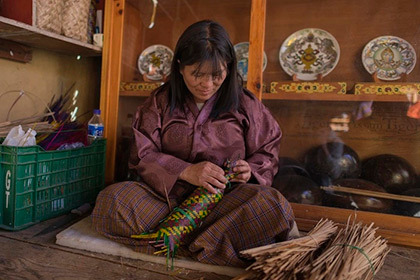
The art is not limited to jewellery only but one can also find a variety of decorative items made up of metal like cups, lamps, swords, flower vases etc. Being a traditional wear, it is quite a common sight finding people wearing ornaments made using this art form in Bhutan.
SHINGZO (WOODWORKING)
While Do zo and Jim zo constitute a significant part in Temples, Dzongs, palaces, and bridges, Shingzo plays a vital role in beautifying these structures. Be it intricately carved pillars, windows or doors, every exquisite design is a masterpiece and worth praising for its uniqueness. Most of the ancient structures are the brilliant work of master carpenters known as Zo Chen and Zo Wo.
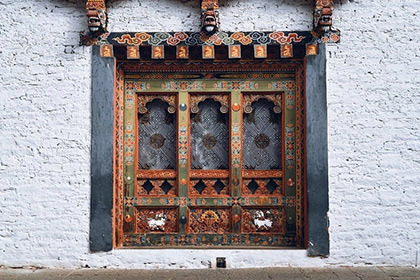
The art has today moved to household furniture as well. One would not have to search for it, as any ancient monument will give you an idea of the craftsmanship. However, we suggest not missing the visit to Punakha Dzong for admiring this art.
LUG ZO (BRONZE CASTING)
The art of bronze casting was introduced in Bhutan around 17th century and was popularized through the newari artists invited by Zhabdrung Nawang Namgyal from Nepal to cast religious items including bronze statues.
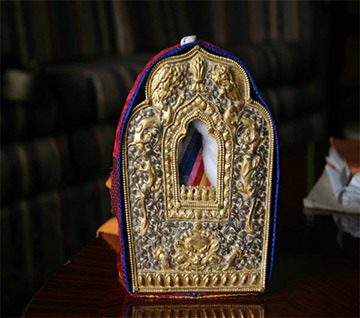
The tradition practised in those days is still continuing and one can find a varied range of bronze items ranging from statues to kitchen utensils crafted and made using either lost wax or sand technique of bronze casting. In ancient times, the lost wax technique was used for religious statues and the sand casting for other ritual items.
The main Budhha statue at Punakha Dzong is one of the best examples of this ancient craft. This statue was crafted along with 1000 other Buddha statues by Gyalsey Tenzin Rabgye, who mastered the wax casting and was also 13th Je Khenopo (Chief Abbot of the Central Monastic Body of Bhutan).
SHAGZO (WOOD-TURNING)

Much before steel and brass made way in making the household utensils, Bhutanese used cups and bowls made of wood that were known as Dapas and Phobs and were created using the art of woodturning. Traditionally practiced in Trashiyangtse, these wooden utensils are made with special wood knots that are highly valued. Another village in eastern Bhutan (Khengar) has made name for making traditional wooden wine containers using this art.
GARZO (BLACKSMITHING)
In around the 14th century, a Tibetan saint Thangtong Gyalpo introduced Garzo (an art of iron or Blacksmithing) to Bhutan.
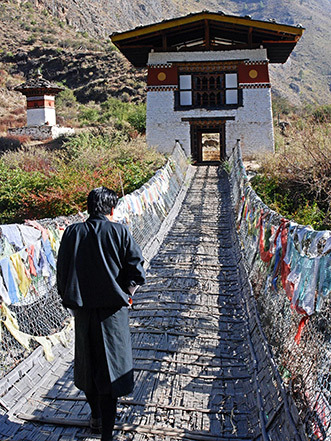
It was the presence of iron ore in abundance, which attracted him to the Land of Thunder (another name of Bhutan). His skill of casting iron chains and constructing bridges resulted in execution of eight suspension bridges in Bhutan. One among them can be seen while driving from Paro to Thimpu, built over river Paro Chhu. One may also visit the National Museum (Paro) to see the remnants of other bridges built by him. With time, the art evolved and now even small tools, armours etc. are also made using the same.
TSHA ZO (BASKETRY)
The art showcases how to make apt use of the natural resources such as bamboos and canes which are available in abundance in Bhutan.
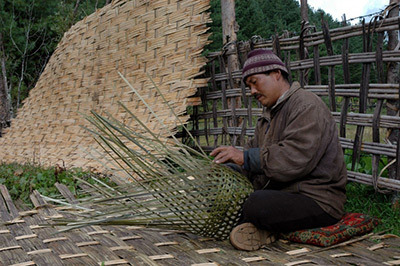
The Bhutanese have mastered the art of weaving cane and bamboo and making a variety of products ranging from house hold items, decorative items, fence for the house, shed for the roofs, baskets etc. The craft is still practised widely in the regions of Kangpara (eastern Bhutan) and Bjokaps (Central Bhutan).
TSHEMZO (TAILORING, EMBROIDERY AND NEEDLEWORK)
This art which covers three areas i.e. tailoring, embroidery, and needlework was traditionally reserved for the royal and religious purposes only. But with time it has reached the common man as well. Today one can see this art on clothes, table runners, and many other similar items.
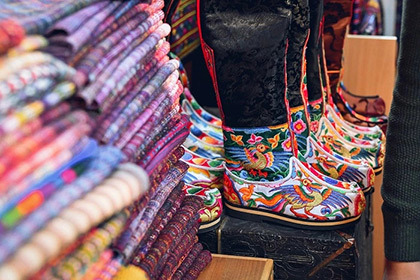
The intricately embroidered Thangkas and Thongdrels that can be seen in Dzongs or monasteries were produced using the same art form. The traditional garments of Bhutan i.e. Gho and Kira as well as traditional boots worn by officials during the special functions / ceremonies were also created following this art form.
PAR ZO (CARVING)
The art which finds its origin in the 14th century, Par Zo dealt with the carving on wood, stone, and slate. With abundant availability of different kinds of wood the Bhutanese artists used the opportunity to create a variety of forms using wood carvings and ranging from wooden masks now generally worn during the monastic and religious festivals to motifs engraved on houses and Dzongs. The most peculiar attention puller among these wood carvings is the wooden phalluses hung on the four corners as well as entrances of traditional houses in Bhutan.
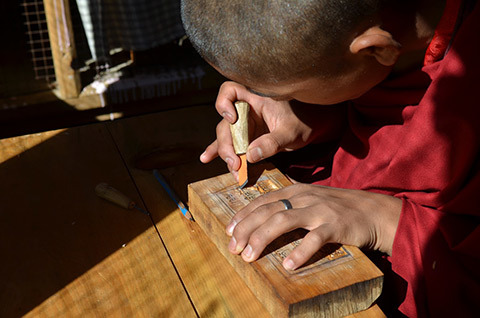
Not as diverse and widely used as wood carving the art of slate carving can be found in engravings, religious scriptures and in religious places likes Dzongs, chortens etc. While stone carving though again less evident, can still be spotted in some villages of Bhutan that are using huge grinding mills.
Every country has some indigenous arts and crafts passed on from generation to generation. But in Bhutan the natives have well preserved and connected the art developed by their ancestors to their inner self and their religion.
Watch this beautiful video of The Last Shangri La and witness a place where happiness still resides. The Government of Bhutan has also played a significant role in keeping these traditional art forms alive and a number of institutes such as National Institute for Zorig Chusum in Thimpu (teaching age-old traditional art and craft to younger generations), National Handicrafts emporium in Thimpu (Exhibits handicrafts, Jewellery, and traditional arts), Folk Heritage Museum in Thimpu (Displays rural life of Bhutan and has furniture as old as 100 years), and National Textile Museum in Thimpu (Exhibits traditional textiles) stands testimony to these efforts.
At Indo Asia Tours, all the trips are curated mindfully to explore the charisma of bold, vibrant, and detailed spectacle of different crafts and artworks.

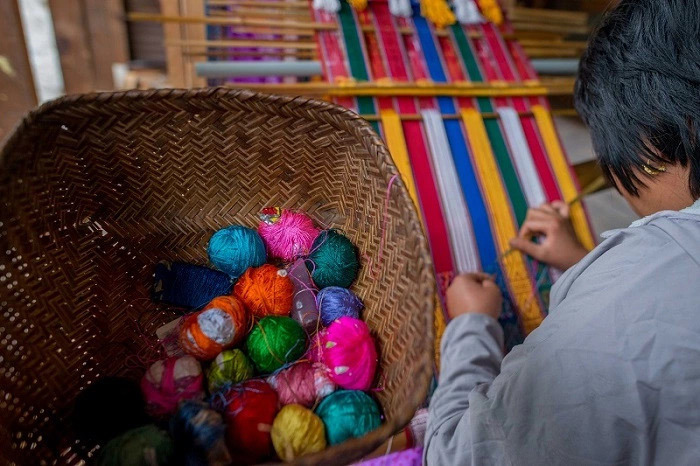
 One will be surprised to know that pigmented soil of different colors found throughout the country is used in these paintings. How sacred the art is to them is evident by the fact that Lha Rips (as the master painters are known locally) do not sign or mention their name on the artworks and believes that it will bring merit to them.
One will be surprised to know that pigmented soil of different colors found throughout the country is used in these paintings. How sacred the art is to them is evident by the fact that Lha Rips (as the master painters are known locally) do not sign or mention their name on the artworks and believes that it will bring merit to them.
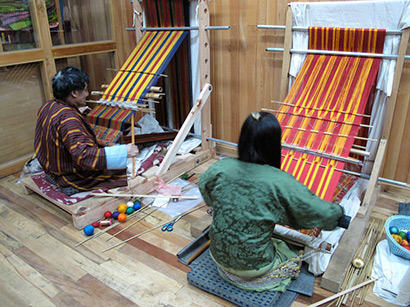 One can consider visiting Adanga, Khoma, Nabji, Khorpu, Decheling, Radi, Bidung, and many such villages, who weave a different kind of textile specific to the village/region. The most spectacular and famous is Kishuthara weaved in Khoma village.
One can consider visiting Adanga, Khoma, Nabji, Khorpu, Decheling, Radi, Bidung, and many such villages, who weave a different kind of textile specific to the village/region. The most spectacular and famous is Kishuthara weaved in Khoma village.
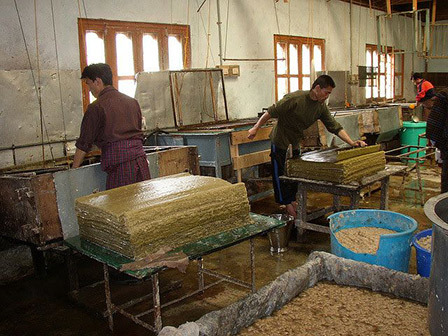 Dezo, which is still preferred in monasteries over the modern paper, is made out of the bark of Daphne and Edgeworthia trees. What makes it special is that it is termite and insect repellent. The art is still practiced in Trashigyantse, for the region has sufficient raw material. One can also visit the handmade paper factory in Thimpu to see this art form.
Dezo, which is still preferred in monasteries over the modern paper, is made out of the bark of Daphne and Edgeworthia trees. What makes it special is that it is termite and insect repellent. The art is still practiced in Trashigyantse, for the region has sufficient raw material. One can also visit the handmade paper factory in Thimpu to see this art form.
 Bhutanese sculptors (also known as Jim zo Lopens) had mastered the art so well that they were pioneers in the Himalayan region and some of them were even called for building sculptures in the monasteries of ancient Tibet. While one can see many clay sculptures all around the country, the most admirable artwork can be found at Taktsang monastery (also called as Tiger Nest) in Paro.
Bhutanese sculptors (also known as Jim zo Lopens) had mastered the art so well that they were pioneers in the Himalayan region and some of them were even called for building sculptures in the monasteries of ancient Tibet. While one can see many clay sculptures all around the country, the most admirable artwork can be found at Taktsang monastery (also called as Tiger Nest) in Paro.
 This ancient art is still widely practiced to build Chortens, Dzongs, houses, bridges etc. While one would come across many stone structures in Bhutan, the best examples of this art work can be found at Choten Kora in Trashiyangtse (Eastern Bhutan) and Chendebji Chorten (Central Bhutan).
This ancient art is still widely practiced to build Chortens, Dzongs, houses, bridges etc. While one would come across many stone structures in Bhutan, the best examples of this art work can be found at Choten Kora in Trashiyangtse (Eastern Bhutan) and Chendebji Chorten (Central Bhutan).
 The art is not limited to jewellery only but one can also find a variety of decorative items made up of metal like cups, lamps, swords, flower vases etc. Being a traditional wear, it is quite a common sight finding people wearing ornaments made using this art form in Bhutan.
The art is not limited to jewellery only but one can also find a variety of decorative items made up of metal like cups, lamps, swords, flower vases etc. Being a traditional wear, it is quite a common sight finding people wearing ornaments made using this art form in Bhutan.
 The art has today moved to household furniture as well. One would not have to search for it, as any ancient monument will give you an idea of the craftsmanship. However, we suggest not missing the visit to Punakha Dzong for admiring this art.
The art has today moved to household furniture as well. One would not have to search for it, as any ancient monument will give you an idea of the craftsmanship. However, we suggest not missing the visit to Punakha Dzong for admiring this art.
 The tradition practised in those days is still continuing and one can find a varied range of bronze items ranging from statues to kitchen utensils crafted and made using either lost wax or sand technique of bronze casting. In ancient times, the lost wax technique was used for religious statues and the sand casting for other ritual items.
The tradition practised in those days is still continuing and one can find a varied range of bronze items ranging from statues to kitchen utensils crafted and made using either lost wax or sand technique of bronze casting. In ancient times, the lost wax technique was used for religious statues and the sand casting for other ritual items.
 Much before steel and brass made way in making the household utensils, Bhutanese used cups and bowls made of wood that were known as Dapas and Phobs and were created using the art of woodturning. Traditionally practiced in Trashiyangtse, these wooden utensils are made with special wood knots that are highly valued. Another village in eastern Bhutan (Khengar) has made name for making traditional wooden wine containers using this art.
Much before steel and brass made way in making the household utensils, Bhutanese used cups and bowls made of wood that were known as Dapas and Phobs and were created using the art of woodturning. Traditionally practiced in Trashiyangtse, these wooden utensils are made with special wood knots that are highly valued. Another village in eastern Bhutan (Khengar) has made name for making traditional wooden wine containers using this art.
 It was the presence of iron ore in abundance, which attracted him to the Land of Thunder (another name of Bhutan). His skill of casting iron chains and constructing bridges resulted in execution of eight suspension bridges in Bhutan. One among them can be seen while driving from Paro to Thimpu, built over river Paro Chhu. One may also visit the National Museum (Paro) to see the remnants of other bridges built by him. With time, the art evolved and now even small tools, armours etc. are also made using the same.
It was the presence of iron ore in abundance, which attracted him to the Land of Thunder (another name of Bhutan). His skill of casting iron chains and constructing bridges resulted in execution of eight suspension bridges in Bhutan. One among them can be seen while driving from Paro to Thimpu, built over river Paro Chhu. One may also visit the National Museum (Paro) to see the remnants of other bridges built by him. With time, the art evolved and now even small tools, armours etc. are also made using the same.
 The Bhutanese have mastered the art of weaving cane and bamboo and making a variety of products ranging from house hold items, decorative items, fence for the house, shed for the roofs, baskets etc. The craft is still practised widely in the regions of Kangpara (eastern Bhutan) and Bjokaps (Central Bhutan).
The Bhutanese have mastered the art of weaving cane and bamboo and making a variety of products ranging from house hold items, decorative items, fence for the house, shed for the roofs, baskets etc. The craft is still practised widely in the regions of Kangpara (eastern Bhutan) and Bjokaps (Central Bhutan).
 The intricately embroidered Thangkas and Thongdrels that can be seen in Dzongs or monasteries were produced using the same art form. The traditional garments of Bhutan i.e. Gho and Kira as well as traditional boots worn by officials during the special functions / ceremonies were also created following this art form.
The intricately embroidered Thangkas and Thongdrels that can be seen in Dzongs or monasteries were produced using the same art form. The traditional garments of Bhutan i.e. Gho and Kira as well as traditional boots worn by officials during the special functions / ceremonies were also created following this art form.
 Not as diverse and widely used as wood carving the art of slate carving can be found in engravings, religious scriptures and in religious places likes Dzongs, chortens etc. While stone carving though again less evident, can still be spotted in some villages of Bhutan that are using huge grinding mills.
Not as diverse and widely used as wood carving the art of slate carving can be found in engravings, religious scriptures and in religious places likes Dzongs, chortens etc. While stone carving though again less evident, can still be spotted in some villages of Bhutan that are using huge grinding mills.
 We can conduct a virtual destination awareness training program for your team or yourself or a virtual tour for your clients. Let us know the destination of your interest along with your convenient date / time and we will be happy to set up a program for you.
We can conduct a virtual destination awareness training program for your team or yourself or a virtual tour for your clients. Let us know the destination of your interest along with your convenient date / time and we will be happy to set up a program for you.



